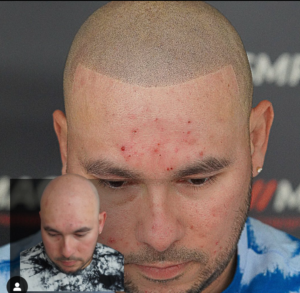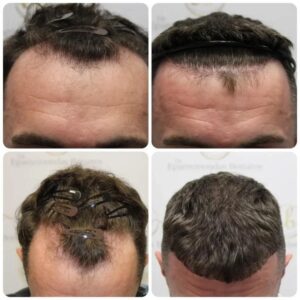Hair loss affects millions of people worldwide, and it can significantly impact their self-esteem and quality of life. While there are several reasons why hair loss can occur, understanding the 7 stages of hair loss and debunking common myths can help you better manage the condition.
In this blog post, we will explore the 7 stages of hair loss, common myths, and effective ways to prevent and treat hair loss.
Table of Contents
Key Takeaway
Hair loss is a common concern for many people, but understanding the 7 stages of hair loss and debunking common myths can help you manage it effectively.
Androgenic alopecia, commonly known as male pattern hair loss, occurs when the immune system mistakenly attacks hair follicles on the top of the head, causing men to lose hair and leading to hair fall from the top of your head.
While genetics and age can contribute to hair loss, lifestyle choices, and health conditions also play a role. Taking proactive steps such as maintaining a healthy diet, avoiding harsh hair treatments, managing stress, and seeking medical advice can help prevent and treat hair loss.
You can overcome hair loss and restore healthy hair growth with the right knowledge and approach.
Norwood-Hamilton Scale and the 7 Stages of Hair Loss
The Norwood-Hamilton scale, also known as the Norwood scale or Hamilton-Norwood scale is a widely used classification system for male pattern baldness. It was developed in the 1950s by Dr. James Hamilton, and later revised and updated by Dr. O’Tar Norwood in the 1970s.
Male pattern baldness, also known as androgenetic alopecia, is the most common type of hair loss in men. It is caused by a combination of genetics and hormones, and typically follows a predictable pattern.
The Norwood-Hamilton scale has seven stages, with stage 1 being the least severe and stage 7 being the most severe. Each stage is characterized by a different pattern of hair loss. Here’s a quick look into the seven stages of hair loss.
Stage 1. No visible hair loss:
There are no signs of hair loss at this stage, and your hair appears to be healthy and full.
Stage 2. Minimal hair thinning:
In this stage, you may notice some hair thinning, especially around the temples and crown of the head. However, it is not noticeable to others.
Stage 3. Noticeable hair loss:
Hair loss is more apparent at this stage, and you may notice a widening part or a receding hairline on the side of the head. Others may also notice that your hair looks thinner. This is the visible stage of all the 7 Stages of Hair Loss. This stage is also known as the stage 3 vertex.
Stage 4. Widespread hair loss:
Hair loss becomes more widespread in this stage, with significant thinning around the crown of the head and the temples. The scalp may also be more visible.
Stage 5. Extensive hair loss:
At this stage, hair loss is severe, with significant balding and thinning across the entire scalp.
Stage 6. Complete hair loss on the scalp:
In this stage, there is complete hair loss on the scalp, leaving the scalp smooth and shiny.
Stage 7. Complete hair loss on the scalp and body:
This is the final of all the seven Stages of Hair Loss. It is the most advanced stage of hair loss. Hair loss extends beyond the scalp, and there is complete hair loss on the entire body, including eyebrows, eyelashes, and body hair.
The Norwood-Hamilton scale is a useful tool for diagnosing and tracking the progression of male pattern baldness and the stages of hair loss. It can also be used to determine the best treatment options for each individual patient.
Not everyone will experience hair loss in all seven stages, and the rate and severity of hair loss can vary from person to person. Understanding the different stages of hair loss is essential to determine the best course of action to prevent and treat hair loss effectively.

Myths vs. Facts about Hair Loss
There are many myths surrounding hair loss, which can often lead to confusion and misinformation. Here are four common myths about hair loss, along with the facts that debunk them:
Myth 1: Wearing hats or helmets causes hair loss.
Fact: No evidence supports the idea that wearing hats or helmets causes hair loss. While hats and helmets can cause hair breakage and tangling, it is safe to say they do not cause hair loss.
Myth 2: Frequent shampooing causes hair loss.
Fact: Washing your hair frequently does not cause hair loss. In fact, washing your hair regularly can help remove dirt and excess oil, which can contribute to hair loss if left unchecked.
Myth 3: Baldness comes from the mother’s side of the family.
Fact: The genetic factors contributing to hair loss can come from both the mother’s and father’s sides of the family. While genetics play a significant role in hair loss, it’s not the only factor.
Myth 4: Hair loss is caused by poor circulation.
Fact: No evidence suggests that poor circulation causes hair loss. While blood flow to the scalp is essential for healthy hair growth, hair loss is more likely caused by genetics, hormonal changes, medications, nutritional deficiencies, or stress.
Myth 5: Everyone goes bald by 50.
This is not true. While hair loss is more common as you age, not everyone will experience significant hair loss or go bald by age 50. Genetics, health conditions, and lifestyle choices can all affect hair loss.
Myth 6: Direct sunshine is bad for your hair.
While excessive sun exposure can damage your hair, moderate sun exposure can benefit your hair and scalp. Sunlight can help stimulate hair growth and improve scalp health by increasing blood flow to the scalp.
Protecting your hair from excessive sun exposure is important by wearing a hat or using a hair care product with SPF.
Myth 7: High levels of testosterone cause hair loss.
This is a common myth, but it is only partially accurate. While testosterone plays a role in hair loss, it is not the sole cause.
The hormone DHT (dihydrotestosterone) is a byproduct of testosterone that can cause hair loss by shrinking hair follicles. Genetics and other factors like stress and poor nutrition can also contribute to hair loss.
Myth 8: Masturbation makes you bald.
There is no scientific evidence to support this myth. Masturbation does not cause hair loss or affect hair growth in any way.
Myth 9: You’re going bald because you’re stressed.
Yes, stress can contribute a great deal to hair loss. However, while stress can contribute to hair loss, it is not the sole cause. Stress can cause a temporary type of hair loss called telogen effluvium, but this type of hair loss is usually reversible.
It’s important to separate fact from fiction when it comes to hair loss. Understanding the true causes of hair loss can help you take the necessary steps to prevent or treat it effectively. Consulting a doctor or a dermatologist can help you determine the underlying cause of your hair loss and develop a personalized treatment plan.
Causes of Male Pattern Baldness
Male pattern baldness is caused by a combination of genetic and hormonal factors. The main hormone involved in male pattern baldness is dihydrotestosterone (DHT). DHT is a derivative of testosterone, and it is produced in the scalp by the enzyme 5-alpha reductase.
DHT binds to hair follicles and causes them to shrink and eventually stop producing hair. This process is known as miniaturization. Miniaturization begins at the temples and crown of the head, and it spreads over time.
Understanding the causes of hair loss can help you better prevent and manage the condition.
Here are some common causes of hair loss:
- Genetics: Androgenetic alopecia, also known as male or female pattern baldness, is the most common type of hair loss, which is largely determined by genetics.
- Hormonal changes: Hormonal changes due to pregnancy, menopause, or thyroid problems can cause hair loss.
- Medications: Certain medications, such as chemotherapy drugs, can cause hair loss as a side effect.
- Nutritional deficiencies: A lack of essential nutrients, such as iron, vitamin D, or biotin, can lead to hair loss.
- Stress: Stress can trigger hair loss, and it’s essential to manage it effectively to prevent hair loss.
Symptoms of Male Pattern Baldness
The most common symptom of male pattern baldness is gradual thinning of the hair at the temples and crown of the head. In some cases, the hair may also thin on other parts of the scalp.
Other symptoms of male pattern baldness may include:
- A receding hairline
- A bald spot on the crown of the head
- A thinning ponytail
- More hair on the brush or in the shower drain than usual
Tips for Preventing and Treating Hair Loss
While it’s not always possible to prevent hair loss, there are several things you can do to reduce your risk or slow down the progression of hair loss. Here are some tips:
- Eating a healthy diet: Make sure you eat a balanced diet rich in vitamins, minerals, and proteins essential for healthy hair
- Avoid harsh hair treatments: Avoid chemical treatments and heat styling tools that can damage your hair and lead to hair loss.
- Managing stress: Practice stress management techniques such as yoga, meditation, or deep breathing exercises to reduce your stress levels.
- Using hair growth products: Many hair growth products are available that can help prevent hair loss and promote hair growth, such as minoxidil and finasteride.
- Consulting a doctor: If you are experiencing hair loss, consult a doctor who can help determine the cause and recommend the appropriate treatment.
Treatment for Male Pattern Baldness
There is no outright cure for male pattern baldness, but there are FDA-approved treatments that can help to slow down the progression of hair loss and promote hair growth.
The most common treatments for male pattern baldness include:
- SMP: Scalp micropigmentation (SMP) is a non-surgical treatment for male pattern baldness that involves depositing tiny dots of pigment into the scalp to create the appearance of a full head of hair. SMP is a permanent solution that can be used to treat any stage of male pattern baldness, and it is especially effective for men who have lost a significant amount of hair.
- Minoxidil (Rogaine): A topical medication that is applied to the scalp once or twice a day. Minoxidil can help to slow down hair loss and promote hair growth in some men.
- Finasteride (Propecia): An oral medication that is taken once a day. Finasteride can help to slow down hair loss and promote hair growth in some men.
- Hair transplant surgery: A surgical procedure that involves transplanting hair follicles from one part of the body to another. Hair transplant surgery can be used to restore hair to the temples, crown, and other areas of the scalp.
Final Words
In conclusion, understanding the seven stages of hair loss or stages of balding, debunking common myths, and knowing the causes and prevention tips can help you manage hair loss effectively.
While hair loss can be distressing, there are many effective treatments like hair transplant available to help restore healthy hair growth. Taking a proactive approach and seeking the help of a medical professional or SMP artist can help you overcome hair loss and regain your confidence.


